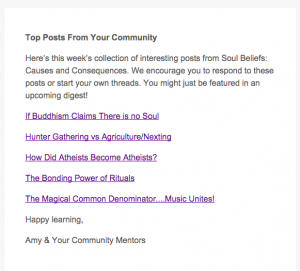Coursera’s shift to an on-demand format dramatically changed how MOOCs are offered on their platform, including some notable changes in how instructors can engage their students in the course content. In a time-limited session format, instructors have been able to email students each week with details about upcoming material, focus discussion in the forums on the current topics, and offer external opportunities – like video chats to prepare for an exam – that matched the needs of the entire student cohort. All of this was possible because the instructor knew where students as a whole were positioned within their content.
In the newer on-demand course format, a student can start at any time and move through the material at their own speed. This offers each student a lot of flexibility but cuts down on the effectiveness of the instructor’s interactions with the cohort by impeding the options mentioned above. It also lessens the raw effectiveness of peer-to-peer interactions when all students in the course are spread across all course stages rather than experiencing the same content at the same time. There are simply fewer students watching a particular video or working on a particular assignment simultaneously.
Coursera’s New Approaches to Engaging Students
This reality has spurred Coursera to investigate potential ways to increase student engagement while retaining the flexibility of the on-demand format. Some of the current options being explored include curated email digests sharing quality student forum activity, a suggested schedule based on the starting date for each student, and live ‘office hours’ led by student volunteers with experience in the course.

The email digest would be a set of approximately five hyperlinks to threads in the discussion forums that exemplify the desired quality of discourse, and it aims to both demonstrate this quality to all active students and draw them into the shared threads. It will be interesting to see if the choice of curator for this feature affects the quality or frequency of digests.
The suggested schedule may replicate, in part, the temporal structure of the session-based courses, offering students guidance for completing the course and potentially giving gentle reminders when they fall off pace. However, the deadlines are suggestions only, with no actual effect on the student’s ability to access the course content and assessments. Also, the schedule does not address the need for gathering and connecting students who are working through the content at the same time; it is unique to each student and visible only to them.
Offering live, student-led office hours is probably Coursera’s most ambitious idea in this push for engagement. Coursera has relied heavily on the enthusiasm and volunteer work of their student participants already, drawing them into efforts for forum moderation, subtitle and course translations, and ever more often into roles as content mentors. Generally these mentors are drawn from students who have successfully completed the course and have ideally shown some interest in helping their fellow students in the forums. It is an open question how well this frequently excellent volunteer effort will transfer into effective leadership of live video events where the mentor may be asked to play the role of content expert in the absence of the instructor or a TA from the university partner.
More fundamental for Coursera’s support model is that it increases the impact of student volunteers on the success or failure of a course and the platform as a whole. If a course is unable to attract enough quality mentors early on, then there may be a cumulative detrimental effect on its future success, because there will be less support in the forums compared to related courses with better mentors. Some Coursera university partners are already cultivating their own communities of quality mentors and even designing specialized training for them. The willingness of the student community to volunteer a significant amount of time and effort has been one of the great discoveries in Coursera’s efforts to scale a quality learning experience for many courses, especially those where the instructor does not have large amounts of time or resources to spend on their MOOC. How far that willingness will extend in the future and what effect there may be in overburdening these student volunteers and relying on them to sustain hundreds of courses are significant questions for Coursera and their university partners as they move forward in this model of education.
